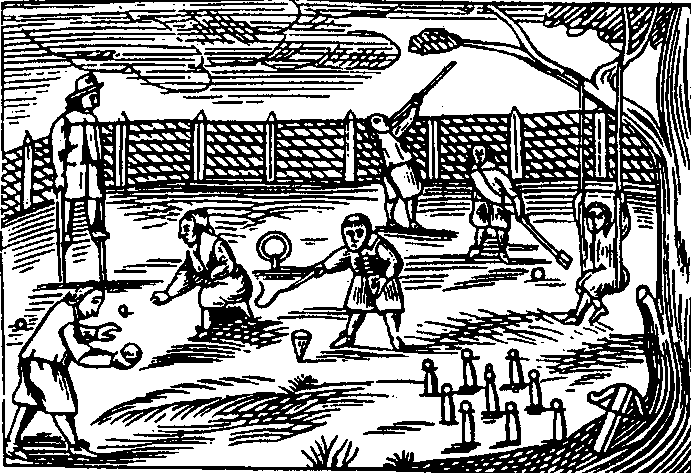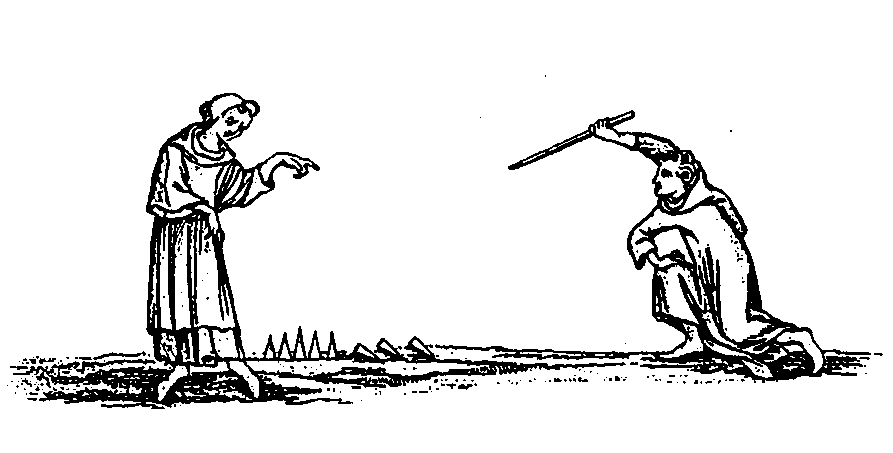
Figure 1.
Playing at Bowls
Presented originally at the University of Atlantia
| The Oak (A&S Newsletter of Atlantia) | Master Dafydd ap Gwystl |
| Issue #13 | kuijt@umiacs.umd.edu |
Brief Notes on History
Bowling dates back at least to the 13th century, as shown by a manuscript of
that century depicting a pair of bowlers. English laws against some sort of
bowling or another appear in 1477, and in 151 1, and again in 1541 (usually in
favor of Archery, which had much more military merit). In the 1541 law anyone
possessed of lands worth at least 100 pounds could get a license to play bowls
on his own land. A bowling green is often found as part of the gardens of a
proper estate of the time. Figure 4 shows an example of a bowling green in a
garden with a turf embankment to stop the bowls from rolling too far. This would
be especially useful in bowling at pins, where violence can be substituted for
precision, and a miss can involve the bowl travelling a considerable distance.
King Henry VIII of England was an avid player at bowls, and his accounts show numerous mention of losses at tile game (his winnings probably would not receive mention in his accounts, and no character as forceful as Great Harry would continue playing a game at which he did not win). Queen Elizabetli is supposed to have played at bowls. The famous account of Sir Waiter Raleigh playing at bowls when the Spanish Armada was siglited is probably apocryphal, but it shows how the game was a favored entertainment of Elizabethan Nobles.
The spheres used in bowling were called Bowls, and I use this nomenclature throughout the descriptions that follow. Bowls was also a way of referring to the game itself, as "playing at Bowls" or "a game of Bowls." Note that in the accounts below Bowling-Alleys are mentioned-these were not necessarily indoors; in many cases they seem to be a grassy "alley" or long rectangle in a garden or other outdoor site.
Games of Bowls
Cones: In a manuscript of the 13th century two bowlers are shown each
standing by a small cone, and bowling towards each otlier's cone. The winner
would probably be the one who first succeeded in knocking over his opponent's
cone, as measuring who came closest would be difficult. There is no name or
description of the game, so I have just called in "cones". Figure 1
shows a redrawing of the 13tli century manuscript taken from J. Strutt.

Figure 1.
Bocce: The game of Bocce, still played in the Mediterranean region of Europe, dates back at least to the ]4th century. A single smaller ball (called the "jack" in 16th and 17th century England) is thrown, and then each player tries to reach it with his Bowls. The winner is the one whose Bowl is the closest. This is the game that seems to have been most common in England in the 16th century. Many references to it, including bowling-alley slang, appear in Shakespeare. Charles Cotton's description of bowling is clearly what we would call Bocce, although he mentions the use of "byassed" bowls for some occasions very probably the sort of biased bowls that are still used in England on some surviving bowling greens. Biased bowls are spheres that are flattened somewhat on one side, making them roll in a spiral rather than straight. The name "Bocce" would not have been used in England, where it would simply be called Bowls. Figure 2 shows a redrawing of a 14th century manuscript taken from J. Strutt.

Figure 2.
Kayles: In this game a number of pins are set up as the target for the bowls. In later illustrations there are invariably nine pins, set up in a square, with one corner of the square pointing towards the bowlers. The center pin, or king pin, is usually slightly larger and differentiated in some way. In earlier illustrations the number of pins may vary. Kayles was often played with a thrown stick replacing the bowl. When played without a king pin the object seems to be to knock down all the pins in the fewest number of throws. With the king pin the game could be won automatically if the king pin could be knocked over while leaving all the other pins standing. Figure 3 shows a woodblock print of a game of Kayles (also called nine-pins) from the 17th century, taken from L. C. Stone.

Figure 3.
Figure 4 shows another woodblock print of a game of Kayles from 1659, taken from J. R. Green.

Figure 4.
Figures 5 and 6 show two examples from 14th century manuscripts showing Kayles being played with six and eight pins and a thrown stick being used rather than a bowl.

Figure 5.

Figure 6.
Four-Corners: This game is much like Kayles, except that four large pins are set up in a square, corner pointing to the bowlers, and an especially large bowl is used. The object is again to knock over all the pins in the fewest number of throws.
Half-Bowl: This game uses a half-sphere of wood, rather than the full sphere of normal bowls. A description of the game as played in 1800 is given here (from J. Strutt). The game uses fifteen small conical pins. Twelve of the pins are arranged equally around the circumference of a two and a half foot diameter circle. One pin is in the center of the circle and two pins are outside the circle so that a line from the bowling position through the center has five pins on it: one on the circle, the center, another on the circle, and then first one and then the other outside pins. The farthest pin is called the end pin. Three pins are marked differently from the others and are worth more points when knocked over. The center pin is marked by having four little spheres on its top; the far pin on the circumference of the circle has three, and the first pin outside the circumference has two. These pins are worth four, three, and two points respectively and all other pins are worth only a single point. To score it is necessary to throw the bowl so that it circles around the end pin before knocking over any pins. If this does not occur no points are scored. The game is played to 31 points.
Cotton's Advice on Bowling
Charles Cotton gives a very interesting description of bowling which I will
reproduce here. Cotton wrote this in 1674, but he copied much of his material
from a tract by Gervase Markham, written in 1615. The game described here seems
to be exclusively what is called Bocce in Italy except that it is sometimes
played with biased bowls, sometimes with round bowls, and sometimes with
"Flat" bowls. The round biased bowls Cotton mentions are probably
spheres flattened on one side so as to roll in an arc rather than straight.
"Flat" bowls might be bowls flattened on both sides. Regardless, it
seems that what type of bowl was used was up to the bowler.
Of Bowling
Bowling is a Game of Recreation, which if moderately used is very healthy for the body, and would be much more commendable than it is, were it not for those swarms of Rooks which so pester Bowling-Greens, Bares, and Bowling-Alleys where any such places are to be found, some making so small a spot of Ground yield them more Annually than fifty Acres of Land shall do elsewhere about the City, and this done, cunning, betting, crafty matching any basely playing booty.
In Bowling there is a great Art in Chusing out his ground, and preventing the windings, hanging, and many turning advantages of the same, wheter it be in open wide Places, as Bares, and Bowling-greens, or in close Bowling-Alleys. Where note that in Bowling the chusing of the Bowl is the greatest cunning. Flat Bowls are best for close Alley; round byassed Bowls for open Grounds of Advantage, and Bowls round as a Ball for green Swarths that are plain and level.
There is no advising by Writing how to Bowl, practice must be your best tutor, which must advise you the Rising, Fallings, and all the several advantages that are to be had in divers Greens, and Bowling-Alleys; all that I shall say, have a care you are not in the first place rookt out of your money; and in the next place you go not to these places of pleasure unseasonably, that is when your more weighty business and concerns require your being at home, or somewhere else.
The Character of a Bowling-Alley and Bowling-Green A Bowling-Green, or Bowling-Ally is a place where three things are thrown away besides the Bowls, viz. Tii.ne, Money, and Curses, at the last ten for one. The best sport in it, is the Gamesters, and he enjoyns it that looks on and betts nothing. It is a School of wrangling, and worse than the Schools; for here Men will wrangle for a hairs bredtli, and make a stir where a straw would end the controversie. Never did Mimmick screw his Body into all the forms these Men do theirs; and it is an Article of their Crred, that the bending back of the Body or screwing in of their Shoulders is sufficient to hinder the over-speed of the Bowl, and that the running after it adds to its speed. Though they are skilful in Ground, I know not what grounds they have for loud lying, crying sometimes the Bowl is gone a mile, a mile, &c. When it comes short of the Jack by six yards, and on the contrary crying Short, Short, when he hath overbowled as far. How senseless these Men appear when they are speaking Sense to their Cast! It is the best discovery of humours, especially in the losers where you may observe fine variety of impatience, whilst some Fret, Rail, Swear, and Cavil at every thing, others Rejoyce and Laugh, as if that was the sole design of their Creation.
To give you the Moral of it, it is the Emblem of the World, or the Worlds Ambition, where most are short, over, wide, orwrong byassed, and some few justle in to the Mistress, Fortune! And here it is as in the Court, where the nearest are the most spighted, and all Bowls aim at the other.
Bibliography
Joseph Strutt, The Sports and Pastimes of the People of England, (1801), edited and enlarged by J. Charles Cox (1903)
Charles Cotton, The Compleat Gamester,(1674; 1930).
J. R. Green and Kate Norgate, editors, A Short History of the English People, (1894)
Lilly C. Stone, English Sports and Recreations, (1960; 1979)